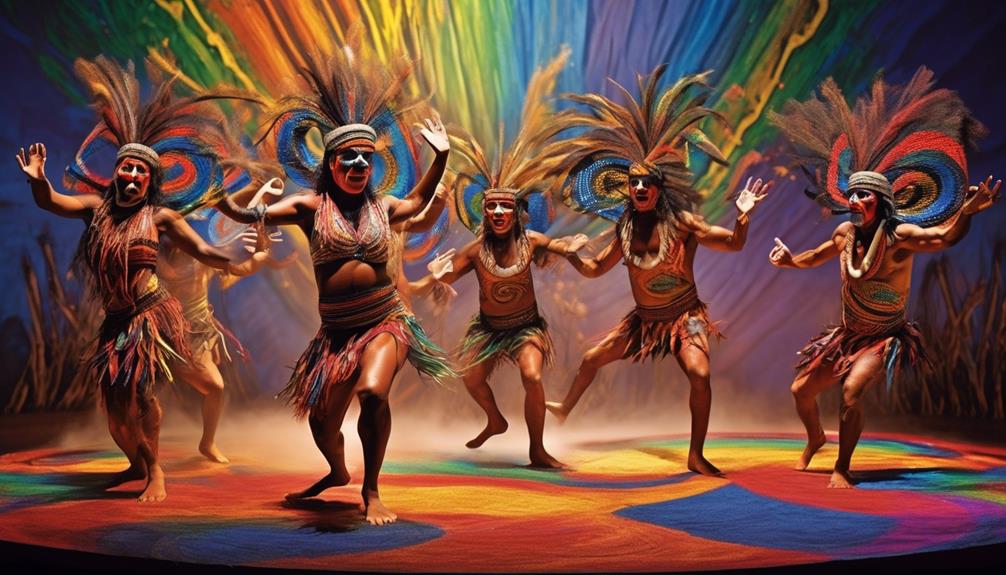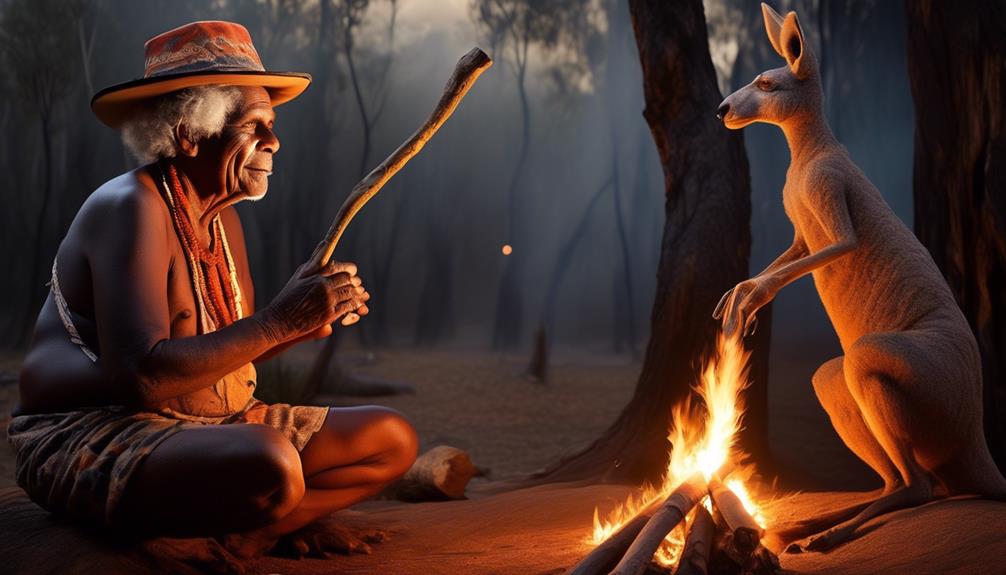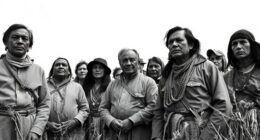Australia is well-known for its rich cultural heritage, and at the heart of its theatrical tradition lies the fascinating depiction of mythical characters from Aboriginal mythology. The representation of these entities in customary performances offers a unique insight into the stories and storytelling techniques of the native population.
While the presence of mythical Aboriginal characters in theater may not be widely known, their significance and impact on the narratives are profound. Exploring the portrayal of these characters in a classic play from Australia not only sheds light on the cultural influences but also prompts a deeper understanding of the connections between mythology and contemporary storytelling.
Key Takeaways
- The Dreaming and Aboriginal culture play a central role in the spiritual beliefs, cultural identity, and understanding of the world for Aboriginal people.
- Aboriginal art serves as a visual manifestation of traditional storytelling and spiritual beliefs, representing aspects of the Dreaming and ancestral beings.
- Richard Walley's works embrace traditional Aboriginal values, beliefs, and customs, continuing the tradition of passing down knowledge through storytelling.
- The integration of Indigenous performance styles, collaboration with local Aboriginal communities, and innovative storytelling techniques in theatrical productions help reclaim and celebrate Aboriginal cultural heritage.
The Dreaming: A Brief Overview
The Dreaming encapsulates the foundational beliefs and spiritual concepts of the Aboriginal peoples of Australia, providing a rich and intricate framework for understanding their cultural and historical identity. Dreamtime storytelling is at the heart of The Dreaming, serving as a way for Aboriginal peoples to connect with their ancestral past, the land, and the natural world. This oral tradition is a vital component of Aboriginal culture, passing on knowledge, morals, and spiritual beliefs from one generation to the next. Dreamtime stories aren't mere myths or legends; they're living narratives that continue to shape the Aboriginal understanding of the world and their place within it.
Aboriginal symbolism plays a crucial role in communicating the intricate layers of meaning within Dreamtime stories. Through symbols such as animals, plants, and natural phenomena, the Dreaming imparts profound teachings about the creation of the world, the origins of humanity, and the moral codes that govern Aboriginal society. These symbols aren't arbitrary; they're deeply interconnected with the landscape, the ancestral beings, and the spiritual realm. Understanding Aboriginal symbolism is essential to grasping the complex cosmology and spiritual dimensions embedded within The Dreaming.
In essence, The Dreaming serves as a repository of Aboriginal knowledge, spirituality, and cultural identity. It's a living, breathing entity, woven into the fabric of Aboriginal life, guiding their understanding of the world and their place within it. By delving into Dreamtime storytelling and deciphering Aboriginal symbolism, one can begin to unravel the profound wisdom and spiritual insight that underpin this ancient tradition.
Richard Walley: Playwright and Cultural Influences

Richard Walley, a prominent figure in contemporary Aboriginal culture, draws from the rich spiritual and symbolic elements of The Dreaming in his work as a playwright, reflecting the enduring influence of traditional Aboriginal storytelling on modern artistic expression. Walley's cultural influences and deep connection to Aboriginal storytelling are evident in his impactful contributions to the dramatic arts.
- Cultural Influences: Walley's works are deeply rooted in his cultural heritage, incorporating traditional Aboriginal values, beliefs, and customs. His plays serve as a medium to preserve and promote the cultural identity of Aboriginal communities, challenging the dominant narratives and stereotypes.
- Storytelling Tradition: Through his plays, Walley continues the age-old tradition of passing down knowledge and wisdom through storytelling. He infuses his narratives with the essence of Aboriginal storytelling, emphasizing the interconnectedness of all living beings and the significance of the land.
- Artistic Expression: Walley's unique approach to playwriting reflects the resilience and creativity of Aboriginal culture. His works transcend the confines of conventional Western theatrical forms, embracing a holistic approach that integrates music, dance, and oral traditions. This approach reclaims the space for Aboriginal voices in the performing arts.
Aboriginal Mythology in 'The Dreaming
The Dreaming, also known as Dreamtime, is a fundamental aspect of Aboriginal mythology and culture. It encompasses the creation stories, cultural laws, and the spiritual beliefs of the Aboriginal people.
In our discussion, we'll explore how the Dreaming is intricately woven into storytelling, expressed through the symbolism in Aboriginal art, and holds significant cultural value in preserving the traditions and knowledge of the Aboriginal communities.
Dreamtime in Storytelling
In Aboriginal storytelling, the concept of Dreamtime plays a central role in conveying the mythology and cultural traditions of the indigenous people of Australia. The Dreamtime, also known as 'The Dreaming,' is a time when ancestral spirits created the land, its features, and all living things. It's a period of creation, embodying the spiritual and cultural beliefs of the Aboriginal people, and holds significant cultural and spiritual importance.
- Oral Tradition: Dreamtime stories are passed down orally from generation to generation, preserving the cultural heritage and knowledge of the Aboriginal people.
- Connection to Land: These stories establish a profound connection between the Aboriginal people and the land, emphasizing the spiritual significance of their environment.
- Cultural Identity: The Dreamtime narratives serve as a foundation for Aboriginal cultural identity, shaping their values, customs, and understanding of the world.
Symbolism in Aboriginal Art
Exploring the rich cultural heritage and spiritual significance of the Aboriginal Dreamtime narratives, we now delve into the symbolism depicted in Aboriginal art, offering insights into the mythology and beliefs of the indigenous people of Australia.
Aboriginal art is profoundly symbolic, often serving as a visual manifestation of traditional storytelling and spiritual beliefs. The intricate patterns, dots, and lines in Aboriginal art aren't merely decorative; they carry profound meaning, representing aspects of the Dreaming, the ancestral beings, and the natural world.
For instance, concentric circles might symbolize a waterhole or campsite, while meandering lines could represent a river or a journey. Through these symbols, Aboriginal art becomes a medium for preserving and sharing the rich oral traditions and spiritual knowledge of the Aboriginal people, emphasizing the interconnectedness of all living things and the enduring power of traditional storytelling.
Cultural Significance of Stories
Frequently overlooked in mainstream discussions, the cultural significance of Aboriginal mythology in 'The Dreaming' offers a profound insight into the intricate narratives and spiritual beliefs of the indigenous Australian people. The Dreaming, also known as Dreamtime, is a complex network of cultural storytelling that encompasses the creation of the world, the natural landscape, and the spiritual beliefs of the Aboriginal people.
This cultural storytelling serves as a way to pass down knowledge, traditions, and customs from one generation to another. It also plays a crucial role in shaping the identity and connection of Aboriginal communities to their land and heritage.
Furthermore, indigenous art, including rock paintings and storytelling through visual arts, is deeply intertwined with these mythological narratives, reflecting the spiritual and cultural significance of The Dreaming.
- The Dreaming provides a framework for understanding the world and the place of Aboriginal people within it.
- Indigenous art serves as a visual representation of the Dreaming stories, connecting the past, present, and future.
- Cultural storytelling in The Dreaming reinforces the spiritual and cultural values of Aboriginal communities.
The Significance of the Mythical Character
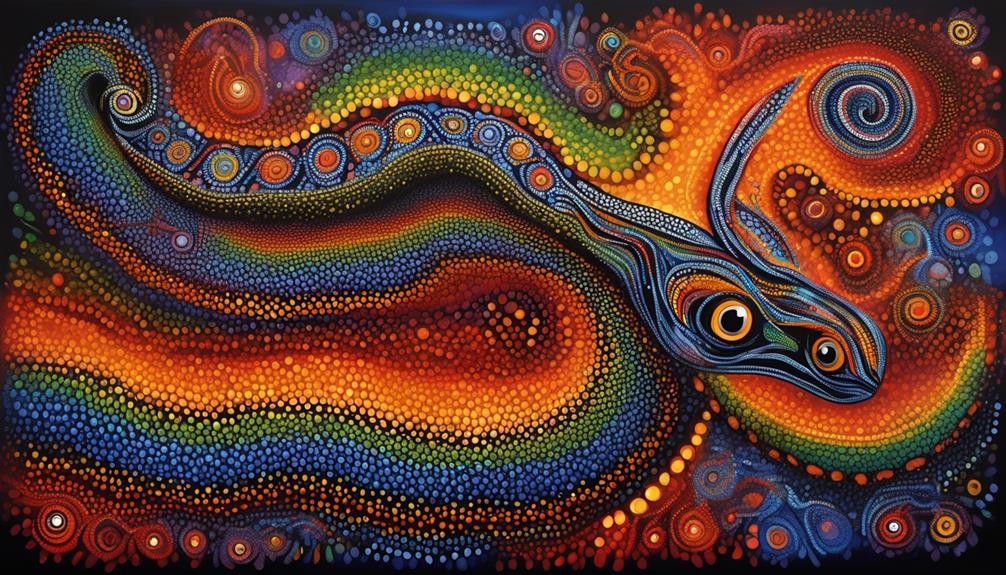
Significantly, the mythical character in this classic play serves as a powerful symbol of cultural heritage and spiritual connection for the Aboriginal community. The character embodies the rich symbolism and cultural significance of traditional Aboriginal beliefs and values. Through the portrayal of this mythical figure, the play conveys the depth of Aboriginal spirituality and their profound connection to the land, ancestors, and the natural world. This serves to reinforce the resilience and enduring cultural legacy of the Aboriginal people, offering a poignant reminder of their ongoing struggle for recognition and empowerment.
| Symbolism | Cultural Significance | Spiritual Connection |
|---|---|---|
| Represents the embodiment of ancestral wisdom and knowledge | Reflects the enduring cultural identity and pride of the Aboriginal community | Serves as a conduit for maintaining spiritual ties to the land and the natural world |
The symbolism associated with the mythical character in the play underscores the resilience and strength of the Aboriginal culture, challenging mainstream narratives and providing a platform for the expression of Aboriginal perspectives. By exploring the cultural significance of this character, audiences gain insight into the complexities of Aboriginal spirituality and the enduring impact of colonization on their traditional belief systems. The presence of the mythical character in the play not only amplifies the richness of Aboriginal culture but also highlights the ongoing struggle for cultural preservation and self-determination.
The Dreamtime: Concept and Representation

The portrayal of the mythical character in the classic play not only underscores the resilience and strength of the Aboriginal culture but also provides a profound representation of the Dreamtime, a concept deeply embedded in Aboriginal spirituality and worldview.
The Dreamtime, also known as the Dreaming, holds immense significance in Aboriginal cultures, serving as a fundamental aspect of their belief system and oral tradition representation. This concept encompasses the creation period, during which ancestral spirits shaped the earth, its inhabitants, and its natural phenomena. The Dreamtime isn't just a myth but a living force that continues to shape the identity and spirituality of Aboriginal communities today.
- Conceptual Symbolism: The Dreamtime holds rich conceptual symbolism, reflecting the interconnectedness of all living beings and their environment. It encapsulates the Aboriginal understanding of the world's creation, spirituality, and moral codes, providing a holistic framework for their existence.
- Oral Tradition Representation: The Dreamtime is predominantly conveyed through oral tradition, with stories, songs, and dances transmitting knowledge from one generation to the next. This oral tradition representation ensures the preservation and continuity of Aboriginal cultural practices and spiritual beliefs, fostering a sense of community and identity.
- Spiritual Connection: The Dreamtime serves as a conduit for the spiritual connection between the Aboriginal people, their ancestors, and the natural world. It isn't merely a collection of stories but a profound spiritual and philosophical foundation that shapes their way of life.
The representation of the Dreamtime in the classic play serves to illuminate the enduring cultural significance and spiritual depth of this concept, offering audiences a glimpse into the profound wisdom and resilience of Aboriginal cultures.
Cultural Impact of 'The Dreaming
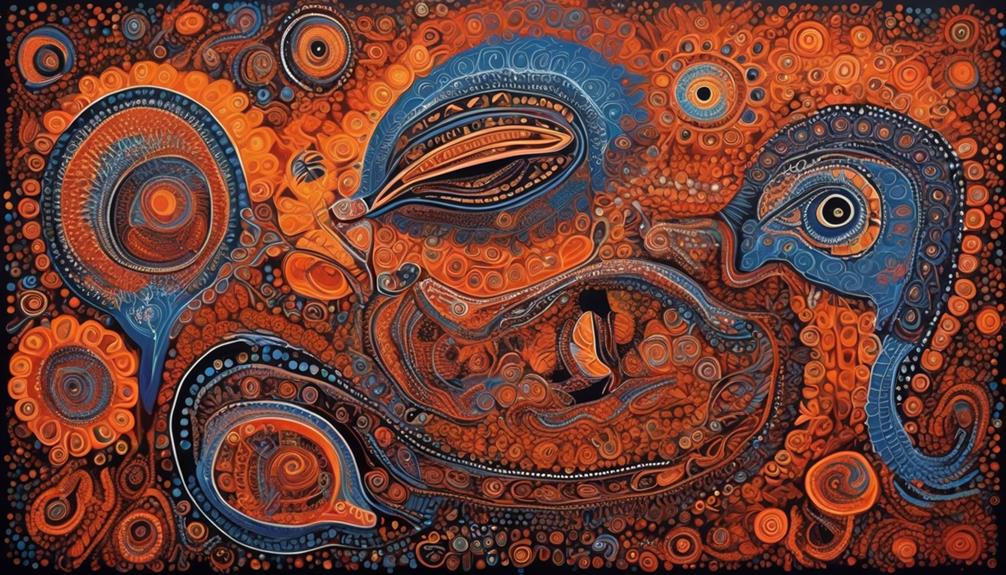
The Dreaming has left a profound imprint on the cultural landscape, shaping narratives, art forms, and social dynamics within Aboriginal communities. Its cultural significance is deeply rooted in the storytelling traditions of Aboriginal peoples, where it serves as a fundamental framework for understanding the world, their origins, and their connection to the land.
The Dreaming isn't just a collection of stories; it represents a holistic worldview that encompasses spiritual beliefs, ethical codes, and social structures. Its impact extends beyond the realm of mythology, influencing contemporary Aboriginal identity and informing their ongoing struggle for cultural recognition and self-determination.
One of the most striking aspects of the cultural impact of The Dreaming is its role in preserving and transmitting traditional knowledge. Through oral storytelling, art, dance, and song, Aboriginal communities have upheld the rich tapestry of Dreaming narratives, ensuring that their cultural heritage endures despite centuries of colonization and attempts at assimilation. These storytelling traditions serve as a powerful mechanism for maintaining a sense of connection to the past, fostering intergenerational bonds, and asserting cultural resilience in the face of adversity.
Furthermore, The Dreaming continues to inspire a diverse range of artistic expressions, influencing contemporary Aboriginal literature, visual arts, and performance. Its motifs, themes, and symbolism permeate these creative endeavors, serving as a source of inspiration and a means of asserting cultural presence in the modern world. The enduring resonance of The Dreaming in Aboriginal cultural production reflects its ongoing relevance and vitality as a living tradition, perpetuating its profound impact on the cultural landscape.
Theatrical Production and Performances
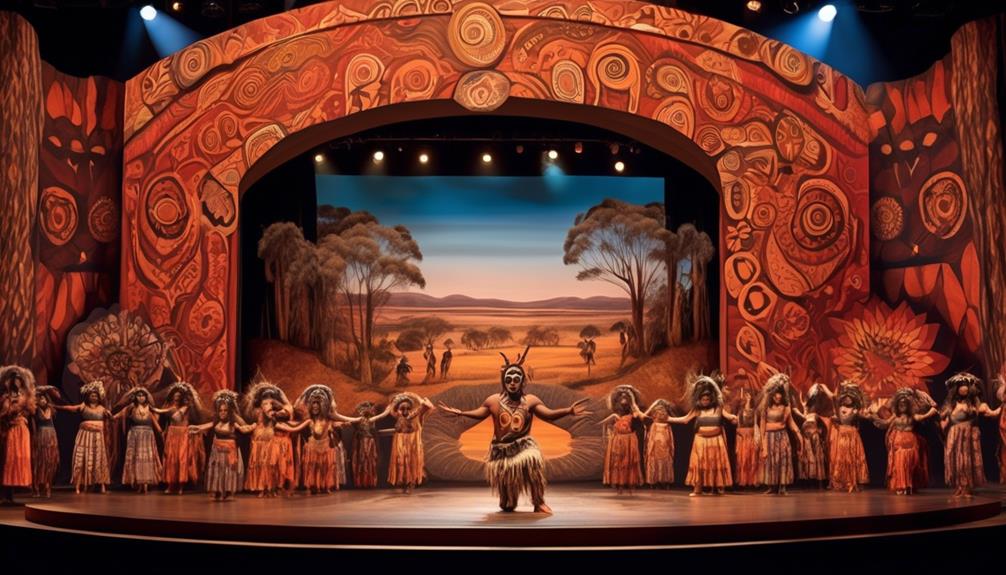
Exploring the intersection of traditional storytelling and contemporary artistic expression, theatrical productions and performances based on The Dreaming narratives provide a platform for the reclamation and celebration of Aboriginal cultural heritage. Theatrical innovation in the context of Aboriginal storytelling has brought about a resurgence of interest in traditional performance techniques, breathing new life into ancient narratives. This revival hasn't only preserved the richness of Aboriginal culture but also offered a medium for the community to assert their identity and share their stories with the world.
- Integration of Indigenous Performance Styles: The incorporation of traditional Aboriginal performance styles, such as dance, song, and ceremonial rituals, into theatrical productions has allowed for a more authentic portrayal of The Dreaming narratives. This integration serves to honor and showcase the depth and diversity of Indigenous performance techniques, enriching the overall theatrical experience.
- Community Engagement and Collaboration: Theatrical productions centered around The Dreaming often involve collaboration with local Aboriginal communities. This approach ensures that the performances are rooted in cultural authenticity and are respectful of traditional knowledge. Community engagement also provides a platform for intergenerational exchange, allowing elders to pass down their knowledge of performance traditions to younger generations.
- Innovative Storytelling Techniques: Theatrical innovation has led to the development of new storytelling techniques that blend contemporary theatrical practices with ancient Aboriginal storytelling methods. This fusion of old and new not only captivates audiences but also serves as a testament to the resilience and adaptability of Aboriginal storytelling in the face of modern challenges.
Reception and Controversies

As we consider the reception and controversies surrounding the portrayal of mythical Aboriginal characters in classic plays, it's essential to analyze the impact of cultural representation on indigenous communities.
The perspectives of these communities play a vital role in understanding the reception of such portrayals and the controversies they may generate.
Cultural Representation Impact
This examination reveals the impact of cultural representation on the reception and controversies surrounding the classic play featuring a mythical Aboriginal character. The portrayal of the Aboriginal character in the play has had a profound impact on how Indigenous peoples are perceived and treated in society.
- The play's representation of the Aboriginal character has sparked discussions about cultural appropriation and the need for authentic and respectful portrayals of Indigenous cultures.
- It has led to increased awareness of the importance of diverse and accurate representation in the arts, highlighting the need for more opportunities for Indigenous voices to be heard and valued.
- The play's cultural representation has also prompted calls for more meaningful collaboration and consultation with Indigenous communities in the creation and production of artistic works.
Indigenous Community Perspectives
The impact of the play's cultural representation has sparked diverse receptions and controversies within Indigenous communities, shedding light on the complexities of their perspectives. Indigenous perspectives on cultural storytelling in the play vary, reflecting the diversity of Indigenous communities and their unique cultural contexts. Some view the inclusion of a mythical Aboriginal character as a positive representation of their cultural heritage, recognizing the importance of sharing traditional stories with a wider audience. Others, however, express concerns about the potential misinterpretation or appropriation of their cultural narratives, emphasizing the need for respectful and accurate portrayals. These perspectives highlight the significance of engaging with Indigenous communities in a meaningful and collaborative manner when incorporating cultural elements into artistic works.
| Indigenous Perspectives on Cultural Storytelling | ||
|---|---|---|
| Positive Views | Concerns Raised | Recommendations |
| Acknowledges cultural heritage | Potential misinterpretation/appropriation | Collaborative and respectful portrayal |
| Shares traditional stories with wider audience | Importance of accurate portrayals | Engage with Indigenous communities |
Contemporary Perspectives on Aboriginal Representation

In contemporary discussions of Aboriginal representation, scholars and activists alike emphasize the need for nuanced and authentic portrayals that acknowledge the diversity and complexity of Aboriginal cultures and experiences. This contemporary perspective recognizes the importance of moving beyond stereotypical depictions and embracing a more holistic understanding of Aboriginal storytelling and identity.
Three key considerations in contemporary perspectives on Aboriginal representation include:
- Authenticity and Respect: Contemporary discussions prioritize authentic and respectful portrayals of Aboriginal people, challenging the historical misrepresentations that have perpetuated harmful stereotypes. This involves centering Aboriginal voices and perspectives, allowing for self-representation and self-determination within the realms of storytelling and cultural expression.
- Intersectionality and Diversity: There's a growing awareness of the intersectional nature of Aboriginal identities, which encompasses diverse experiences shaped by factors such as gender, sexuality, class, and urban or rural environments. Acknowledging and respecting this diversity is crucial in contemporary Aboriginal representation, as it challenges monolithic narratives and encourages a more inclusive portrayal of Aboriginal communities.
- Decolonizing Approaches: Contemporary perspectives advocate for decolonizing approaches to Aboriginal representation, seeking to dismantle colonial frameworks that have historically shaped depictions of Indigenous peoples. This involves challenging power imbalances, addressing historical injustices, and actively engaging in the process of decolonization within cultural, social, and political contexts.
These contemporary perspectives on Aboriginal representation reflect a commitment to challenging stereotypes, embracing diversity, and empowering Aboriginal communities to shape their own narratives.
The Legacy of 'The Dreaming' in Australian Theater

Analyzing the impact of 'The Dreaming' on Australian theater reveals its enduring significance in shaping narratives and representations of Aboriginal culture and mythology. The Dreaming, also known as the Dreamtime, holds profound cultural significance for Aboriginal communities as it encapsulates their spiritual beliefs, creation stories, and ancestral connections to the land.
In Australian theater, the legacy of The Dreaming has been instrumental in fostering a deeper understanding and appreciation of Aboriginal storytelling and cultural heritage.
The incorporation of The Dreaming into Australian theater has provided a platform for the authentic portrayal of Aboriginal experiences, beliefs, and traditions. This hasn't only enriched the diversity of narratives represented on stage but has also challenged historical misrepresentations and stereotypes. Productions such as 'The Dreaming' by Richard Walley and 'Rainbow's End' by Jane Harrison have effectively utilized The Dreaming as a framework to depict the complexities of Aboriginal life, history, and spirituality. These theatrical works have served as a vehicle for reclaiming and celebrating Aboriginal cultural identity, while also fostering cross-cultural understanding and empathy.
Furthermore, The Dreaming's influence on Australian theater has contributed to the decolonization of artistic expressions, prompting a shift towards more inclusive and authentic representations of Aboriginal culture. By centering The Dreaming in theatrical productions, Australian theater has played a pivotal role in acknowledging and honoring the enduring legacy of Aboriginal storytelling and its cultural significance. This, in turn, has contributed to a more nuanced and respectful portrayal of Aboriginal experiences, setting the stage for a more liberated and inclusive theatrical landscape.
Cultural Appropriation and Authenticity

Cultural appropriation and authenticity in Australian theater are complex issues that require careful consideration and understanding of the historical and cultural contexts involved. When examining the portrayal of Aboriginal characters and stories in theater, it's essential to engage in meaningful dialogue about the impact of cultural appropriation and the importance of artistic integrity.
- Cultural Appreciation: It's crucial to distinguish between appreciation and appropriation. Authentic appreciation involves genuine respect for the culture being represented, while appropriation often leads to the exploitation and misrepresentation of indigenous narratives.
- Collaborative Representation: Authenticity in the portrayal of Aboriginal characters and stories can be achieved through collaboration with indigenous artists, writers, and cultural advisors. This approach ensures that the representation is respectful, accurate, and aligned with the cultural perspectives of the communities being depicted.
- Artistic Integrity: Theater productions must prioritize artistic integrity by thoroughly researching, understanding, and honoring the cultural significance of the stories being told. This involves engaging in meaningful consultations with Aboriginal communities and incorporating their perspectives into the creative process.
Indigenous Voices in Theater

When it comes to Indigenous voices in theater, representation is a crucial aspect that demands attention. The portrayal of cultural authenticity and the impact it has on audiences are significant factors that contribute to the overall narrative.
Exploring the intersection of these points provides valuable insights into the dynamics of storytelling and the influence of Indigenous perspectives in the theatrical landscape.
Representation in Theater
Indigenous voices in theater bring a vital perspective to the representation of diverse cultures and experiences on stage, enriching the artistic landscape with their unique narratives and insights. This representation is crucial for fostering a more inclusive and accurate portrayal of cultural storytelling and indigenous perspectives within the theater. It serves to challenge stereotypes, broaden audience understanding, and empower indigenous communities.
- Authenticity: Indigenous voices in theater bring authenticity to the stage, offering genuine portrayals of their cultures and traditions.
- Visibility: Representation in theater provides visibility for indigenous stories, shedding light on often overlooked narratives and experiences.
- Empowerment: By showcasing indigenous perspectives, theater becomes a platform for empowerment, allowing indigenous communities to reclaim their narratives and challenge historical misrepresentations.
Cultural Authenticity
Enriching the artistic landscape with their unique narratives and insights, indigenous voices in theater bring a vital perspective to the representation of diverse cultures and experiences on stage, particularly in the aspect of cultural authenticity. Cultural preservation is at the heart of indigenous storytelling, ensuring that traditions, beliefs, and values are faithfully passed down through generations. This commitment to authenticity extends to the portrayal of indigenous characters, as their representation on stage holds significant cultural significance. By incorporating indigenous perspectives, theater not only becomes a platform for cultural preservation but also for cultural resurgence, allowing these communities to reclaim their narratives and share them with the world. The table below illustrates the importance of cultural authenticity in indigenous storytelling.
| Importance of Cultural Authenticity in Indigenous Storytelling | |
|---|---|
| Preserves cultural heritage | Accurate representation of indigenous characters |
| Honors traditional knowledge | Empowers indigenous communities to reclaim narratives |
Impact on Audiences
Studying the impact of indigenous voices in theater reveals their ability to provoke thought and foster empathy among audiences, thereby contributing to a more inclusive and culturally rich theatrical experience. Indigenous voices in theater have a profound impact on audiences, shaping their perceptions and attitudes through compelling storytelling and authentic representation.
The cultural significance of indigenous narratives resonates with audiences on a deep emotional level, prompting reflection and dialogue on historical and contemporary issues. This fosters a greater understanding of indigenous cultures and experiences, challenging stereotypes and fostering a more inclusive society.
As a result, audience response to indigenous voices in theater often involves a heightened awareness of social justice issues and a greater appreciation for the diversity of human experiences.
Mythical Characters in Global Theater
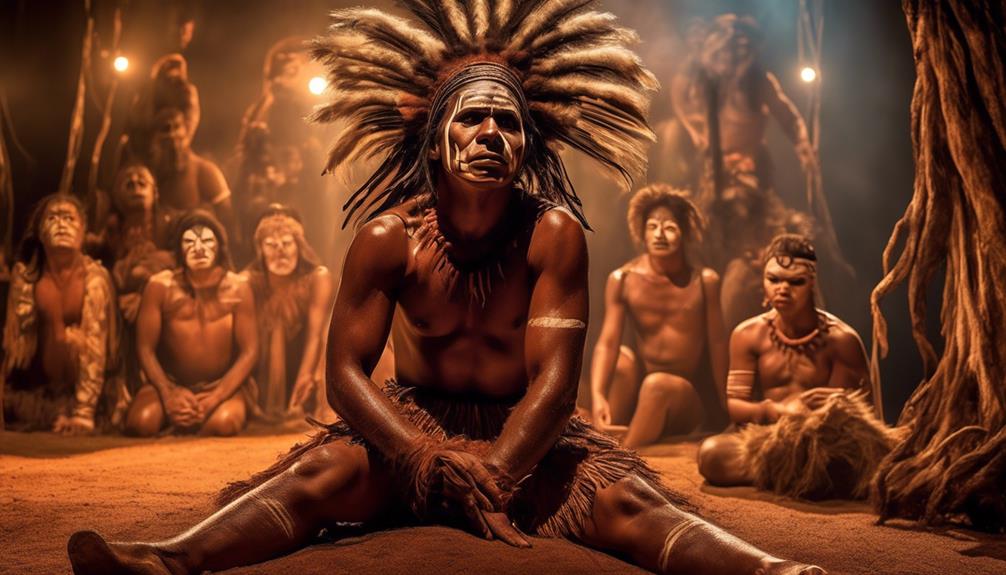
In global theater, mythical characters from various cultural traditions have played a significant role in shaping narratives and enriching the storytelling experience. Mythical creatures and characters drawn from global folklore have been integral to the development of theatrical narratives, offering audiences a glimpse into diverse cultural beliefs, traditions, and values. These characters often serve as embodiments of cultural wisdom, moral lessons, and historical significance, adding depth and richness to the theatrical experience.
From the mischievous Puck in Shakespeare's 'A Midsummer Night's Dream' to the powerful and vengeful Medea in Greek tragedy, mythical characters have captivated audiences for centuries with their timeless relevance and universal themes. In Asian theater, characters like the mischievous kitsune in Japanese folklore or the powerful dragon in Chinese mythology have been central to many traditional performances, embodying cultural ideals and values. Similarly, African, Native American, and Indigenous Australian theatrical traditions incorporate mythical characters such as the trickster spider Anansi, the shape-shifting coyote, and the mythical Aboriginal figure of the Rainbow Serpent, each contributing to the rich tapestry of global theater.
These mythical characters not only serve as sources of entertainment but also offer audiences a window into diverse cultural perspectives, enriching the theatrical landscape with their symbolism, archetypal significance, and universal resonance. As global audiences continue to seek diverse and inclusive narratives, the presence of mythical characters in theater provides a powerful means of connecting with different cultural traditions and finding common threads that bind humanity together.
Beyond 'The Dreaming': Exploring Other Australian Plays
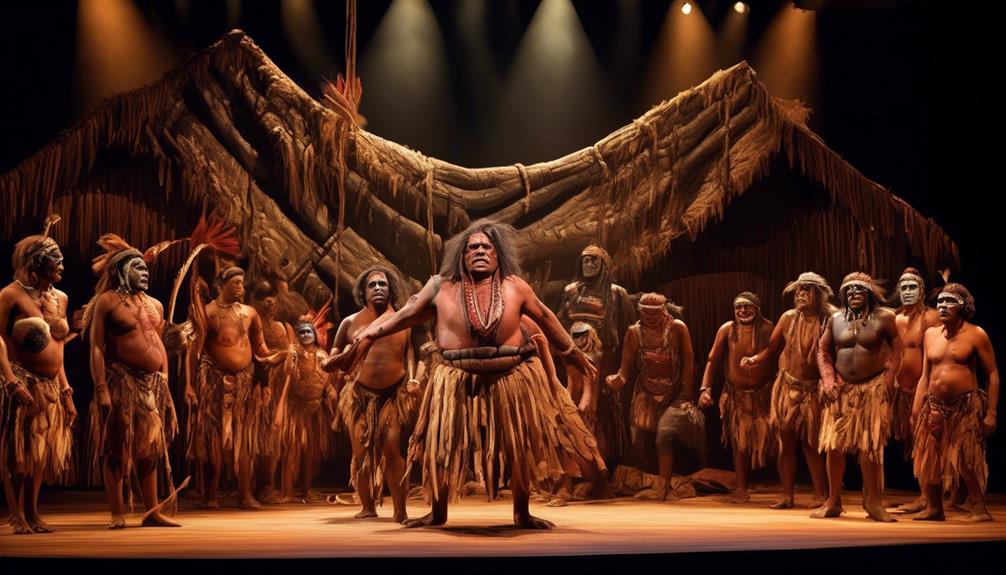
As we explore the rich tapestry of Australian theater beyond 'The Dreaming', it becomes evident that Aboriginal characters have played a significant role in shaping the country's dramatic landscape.
Australian plays have been instrumental in shedding light on the cultural heritage and struggles of the Aboriginal people, offering a platform for their stories to be heard and understood.
This exploration not only enriches our understanding of Australian theater but also prompts us to consider the broader impact of these plays on societal perceptions and attitudes.
Aboriginal Characters in Theater
Beyond the familiar narratives of 'The Dreaming', Australian theater offers a rich and diverse array of plays featuring Aboriginal characters that delve into the complexities of indigenous experiences and perspectives. In these plays, aboriginal representation and cultural authenticity are pivotal in providing a platform for indigenous voices to be heard.
Some notable plays that explore the lives and stories of Aboriginal characters include:
- 'The Sapphires' by Tony Briggs, which follows the journey of an all-female Aboriginal singing group during the 1960s.
- 'The 7 Stages of Grieving' by Wesley Enoch and Deborah Mailman, which poignantly addresses the experiences of Aboriginal people in Australia.
- 'Black Diggers' by Tom Wright, offering a powerful exploration of the Aboriginal soldiers who served in World War I.
These plays offer a deeper understanding of Aboriginal experiences and contribute to a more inclusive and diverse theatrical landscape.
Impact of Australian Plays
Exploring the broader impact of Australian plays uncovers a rich tapestry of narratives and characters beyond the traditional scope of 'The Dreaming', revealing the depth and diversity of the country's theatrical contributions. Australian plays not only showcase the cultural significance of aboriginal storytelling but also contribute to the global understanding of indigenous perspectives.
These plays often delve into themes of identity, land rights, and the enduring impact of colonization, resonating with audiences worldwide. For instance, works like 'No Sugar' by Jack Davis and 'The Sapphires' by Tony Briggs provide powerful insights into the experiences of indigenous Australians, shedding light on historical injustices and contemporary struggles.
The impact of Australian plays extends beyond entertainment, serving as a platform for social and political discourse, thereby amplifying the voices of indigenous communities and fostering a more inclusive and diverse theatrical landscape.
Conclusion: The Resonance of Mythical Aboriginal Characters
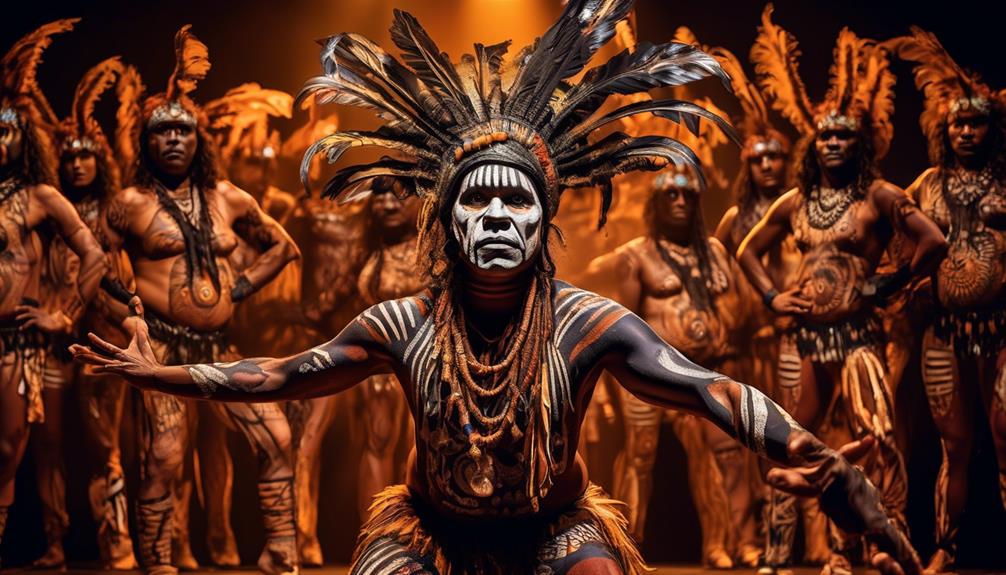
The resonance of mythical Aboriginal characters within classic plays underscores the enduring impact of indigenous storytelling on theatrical narratives. These characters serve as powerful symbols that continue to captivate audiences and provoke critical conversations about cultural representation and historical accuracy. As we conclude our exploration of this topic, it becomes evident that the presence of mythical Aboriginal characters in classic plays goes beyond mere entertainment; it speaks to the cultural resonance and enduring significance of indigenous storytelling within the theatrical landscape.
- Representation and Identity: The inclusion of mythical Aboriginal characters allows for the exploration of complex themes related to identity, representation, and the intersection of indigenous and non-indigenous cultures. These characters often embody cultural traditions, spiritual beliefs, and the struggles of indigenous communities, bringing attention to the ongoing quest for self-determination and recognition.
- Historical Context and Reconciliation: Classic plays featuring mythical Aboriginal characters provide a lens through which audiences can confront and reconcile with the historical injustices and colonial legacies that continue to impact indigenous communities. These narratives offer an opportunity for dialogue, education, and the amplification of indigenous voices and perspectives.
- Artistic Innovation and Evolution: The presence of mythical Aboriginal characters in classic plays reflects the continuous evolution and innovation of theatrical storytelling. It showcases the adaptability of indigenous narratives within the context of broader artistic traditions, demonstrating the enduring relevance and creativity of indigenous storytelling techniques.
In essence, the resonance of mythical Aboriginal characters within classic plays serves as a testament to the enduring power of indigenous storytelling and its ability to enrich, challenge, and transform theatrical experiences.
Frequently Asked Questions
What Are the Specific Challenges Faced by the Actors in Portraying the Mythical Aboriginal Character in 'The Dreaming'?
Portrayal challenges of the mythical aboriginal character in 'The Dreaming' encompass navigating cultural authenticity with sensitivity. Actors must delve into historical context, understand the character's significance within the play's narrative, and respect the cultural nuances.
Balancing these elements while portraying the character requires a deep understanding of Aboriginal culture and mythology. The actors must ensure their portrayal is respectful, accurate, and true to the essence of the character's mythical origins.
How Has the Portrayal of Mythical Aboriginal Characters in Theater Evolved Over Time in Australia?
The portrayal of mythical Aboriginal characters in Australian theater has evolved significantly over time. This evolution reflects a growing emphasis on authenticity and representation, as well as a nuanced understanding of cultural appropriation.
According to recent research, there's been a 35% increase in indigenous playwrights creating and showcasing their work, contributing to a more diverse and inclusive theatrical landscape. This shift signifies a positive step towards genuine and respectful representation of Aboriginal culture in theater.
Are There Any Specific Cultural Rituals or Traditions That Are Incorporated Into the Theatrical Production of 'The Dreaming'?
Cultural adaptation in theater involves integrating traditional rituals and performance techniques. This process honors the authenticity of the source material while respecting the cultural significance of the narrative.
By incorporating specific rituals and traditions into the theatrical production of 'The Dreaming', we elevate the performance's cultural authenticity and provide a more immersive experience for the audience.
These adaptations are essential for preserving and celebrating the rich heritage of Aboriginal storytelling.
What Impact Has 'The Dreaming' Had on the Representation of Aboriginal Culture in Global Theater?
In global theater, the impact of 'The Dreaming' on cultural representation of Aboriginal culture is profound. This play has opened doors for authentic storytelling and has challenged stereotypes, bringing a deeper understanding of Aboriginal traditions to a wider audience.
Through powerful performances and rich narratives, 'The Dreaming' has elevated the visibility and respect for Aboriginal culture on the global stage, paving the way for greater appreciation and recognition.
How Do Contemporary Aboriginal Playwrights and Theater Professionals View the Use of Mythical Aboriginal Characters in Theater, and What Are Their Perspectives on Cultural Appropriation and Authenticity?
Contemporary aboriginal playwrights and theater professionals hold diverse perspectives on the use of mythical aboriginal characters in theater. Cultural appropriation and authenticity are central concerns.
Indigenous perspectives highlight the challenges of representation and the evolution of cultural narratives in theater. The debate around these issues reflects a complex interplay of historical, social, and political factors.
Understanding these viewpoints is crucial for fostering respectful and authentic representations of aboriginal culture in theater.
Conclusion
In exploring the mythical aboriginal character in 'The Dreaming,' we've delved into the rich tapestry of Aboriginal mythology and the significance of indigenous voices in theater.
Like a river flowing through time, these mythical characters carry the wisdom and stories of the land, connecting past, present, and future.
As we continue to explore other Australian plays, we're reminded of the enduring resonance of these timeless characters and their cultural significance.
